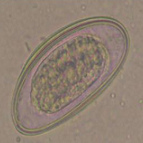Loading Shopping Cart Items...

FREE FOR MEMBERS!
Description: This course will cover the natural history of intestinal and urogenital nematode parasites infecting humans, including typical disease symptoms in the infected host and the usual means of diagnosis.
There are no prerequisites; however, for a practical and comprehensive knowledge of the helminths that may be recognized in stool and urine samples, it is strongly recommended that the learner also complete the courses on cestodes and trematodes of the intestinal and urogenital tracts.
Start date: Upon registration
Completion: Up to 52 weeks
Learning Outcomes:
Author: Rosemary Drisdelle, BA, ART, MLT
Version Date: February 2021
PEP hours: 7.5
CPS credits: 0
*Note: PEP hours and/or CPS credits will only be awarded upon successful completion of Final Exam.